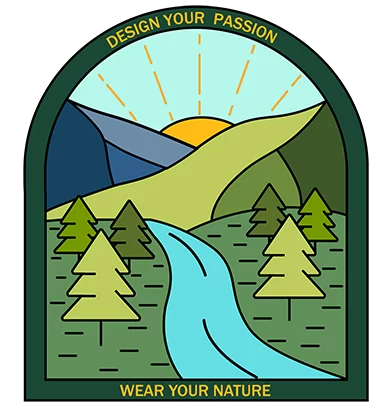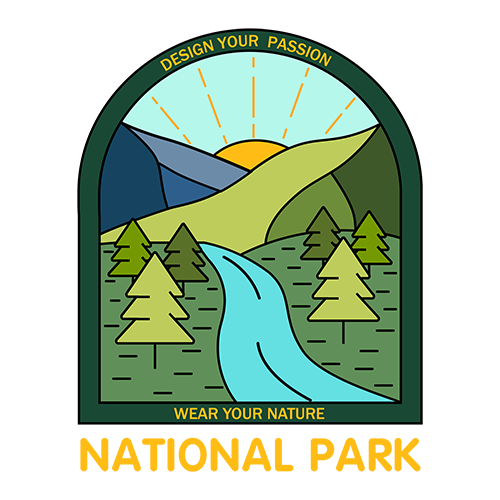As a seasoned traveler, I’ve had the privilege of exploring some of the most breathtaking destinations around the world. But there’s one place that still leaves me in awe – Acadia National Park, a true gem on the eastern seaboard of the United States. And at the heart of this natural wonderland is the Acadia National Park Visitor Center, a treasure trove of information and inspiration that sets the tone for an unforgettable adventure.
From the moment you step inside, you’ll be greeted by the warm smiles of the park rangers and volunteers, who are eager to share their knowledge and passion for the park. The visitor center is more than just a stopping point for maps and brochures – it’s a gateway to the park’s secrets, a hub of activity that will fuel your curiosity and get you excited for the adventures ahead. So come and discover the magic of Acadia National Park with me, and let’s explore the wonders that await us at the visitor center.
About the Hulls Cove Visitor Center, Acadia National Park
Hulls Cove Visitor Center serves as the main contact station for Acadia National Park. Visitors can access information and Island Explorer bus stops from a covered pavilion in the parking lot. The Acadia National Park visitor center is accessible by climbing 52 stone steps from the parking lot, where visitors can purchase entrance passes, speak with rangers, use self-service maps, view art from the Artist-in-Residence program, and shop at the Park Store. For those needing an accessible entrance, signs direct them to drive to the rear of the building and use the elevator.
Originally serving as both the park’s administrative headquarters and visitor center, Hulls Cove Visitor Center was designed in 1967 and completed in December 1986. It was funded through the Mission 66 Program, which aimed to improve infrastructure in national parks from 1956 to 1966. The design of the visitor center departed from the rustic pre-World War II style of NPS architecture, embracing contemporary forms due to material scarcity post-WWII. Mission 66 buildings reflected a new NPS commitment to interpret park resources for visitors and accommodate increased staffing levels by grouping various services into one complex.
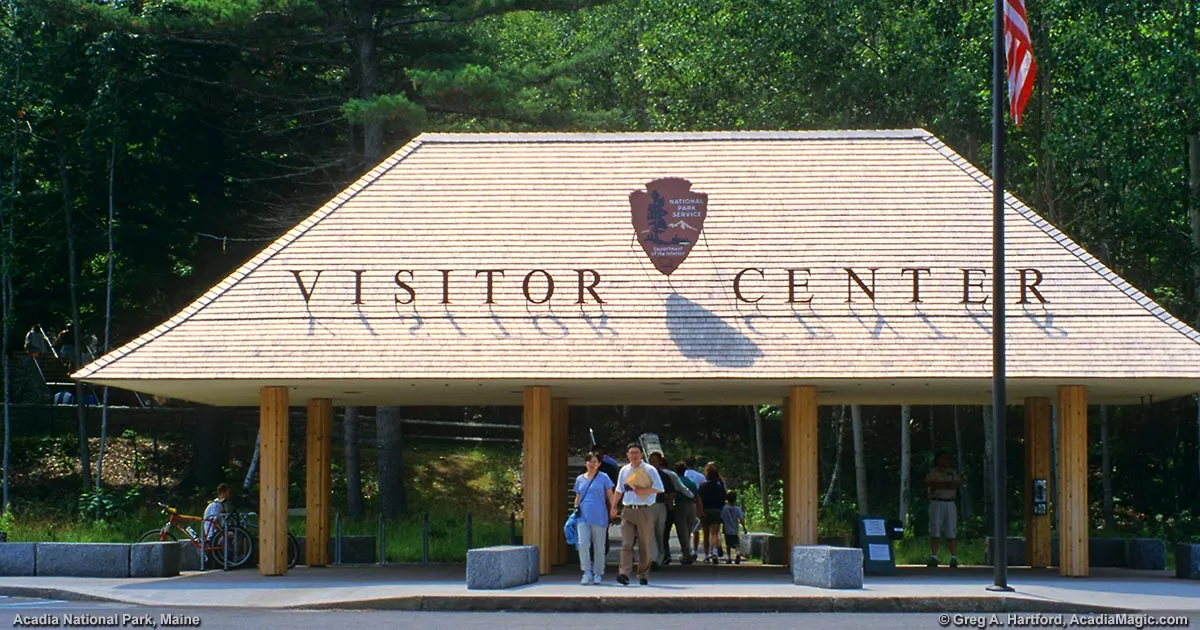
The Hulls Cove Visitor Center is located on a small cleared area on the northeast side of Paradise Hill. It is a rectangular trapezoid building with a flat roof, covered in shingles and built on a granite ashlar first story. The main lobby of the center can be accessed via an original concrete and wood bridge, which is adorned with granite stones and diagonal boards for handrails. The building and its approach are constructed using locally available materials such as wood and granite. The building measures 65 feet in length and 22 feet in width.
In 1995, a two-story addition was built on the northeast side of the visitor center to create space for an accessible entrance and restrooms. A second entrance was added through a concrete bridge supported by two columns, providing an exit from the previously removed auditorium.
Upon entering the building, visitors are greeted with a large number of windows that once offered a stunning view of Frenchman’s Bay. Unfortunately, the view is now obstructed by trees that have grown over time.
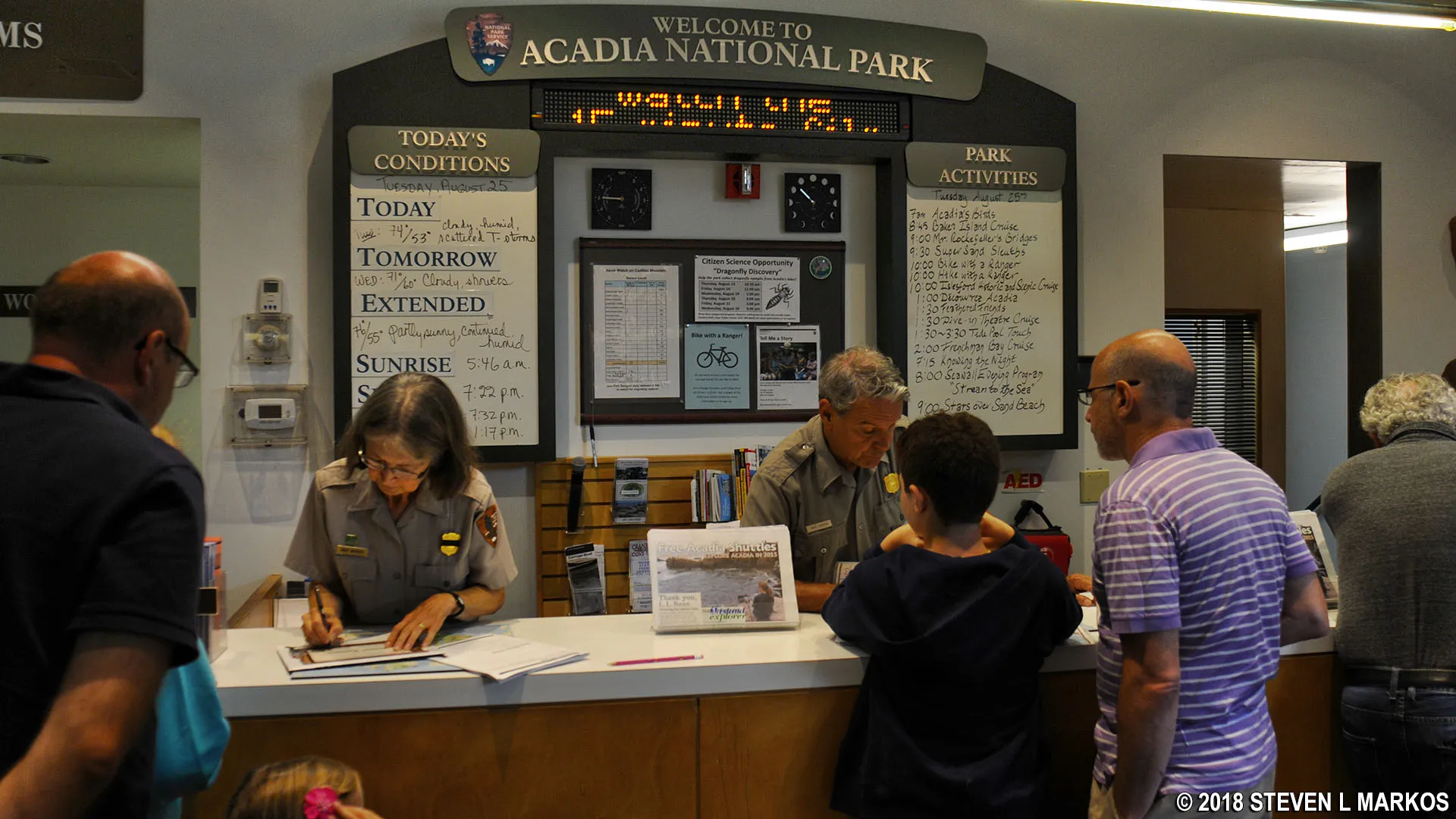
Things to know before visiting Acadia National Park Visitor Center
Before you embark on your journey to the Acadia National Park Visitor Center Hulls Cover, there are a few key things you should know to make the most of your experience.
To ensure a smooth and enjoyable visit, it’s recommended to come prepared. Bring comfortable walking shoes, as you may want to explore the nearby trails and scenic overlooks. Pack a reusable water bottle, as the visitor center has refilling stations to help reduce plastic waste.
Consider bringing binoculars or a camera to capture the stunning natural beauty surrounding the center. Check the weather forecast and dress accordingly, as the weather in Acadia can be unpredictable.
Read More: Best Hikes In Acadia National Park

If you are unable to climb the 52 steps from the parking lot to the visitor center, there is an elevator at the back of the building that you can use.
The Island Explorer shuttle bus stops in the parking lot and is a free option for those who prefer to use public transportation. This bus runs seasonally and makes various stops in the Acadia/Bar Harbor area.

Best things to do at Hulls Cove Visitor Center
The Hulls Cove Visitor Center is much more than just a place to gather information; it’s a hub of activity and exploration. Here are some of the best things to do in Acadia during your visit.
Chat With a Park Ranger
At the Hulls Cove Visitor Center, visitors can find a variety of maps and brochures available for purchase or perusal. Yet, the most effective way to gain knowledge about Acadia National Park is by engaging in conversation with one of the park rangers. These knowledgeable individuals are equipped to address any inquiries you may have regarding the park, the surrounding area, and the history of Acadia. Additionally, they can furnish you with a map of the park to assist you in commencing your exploration.
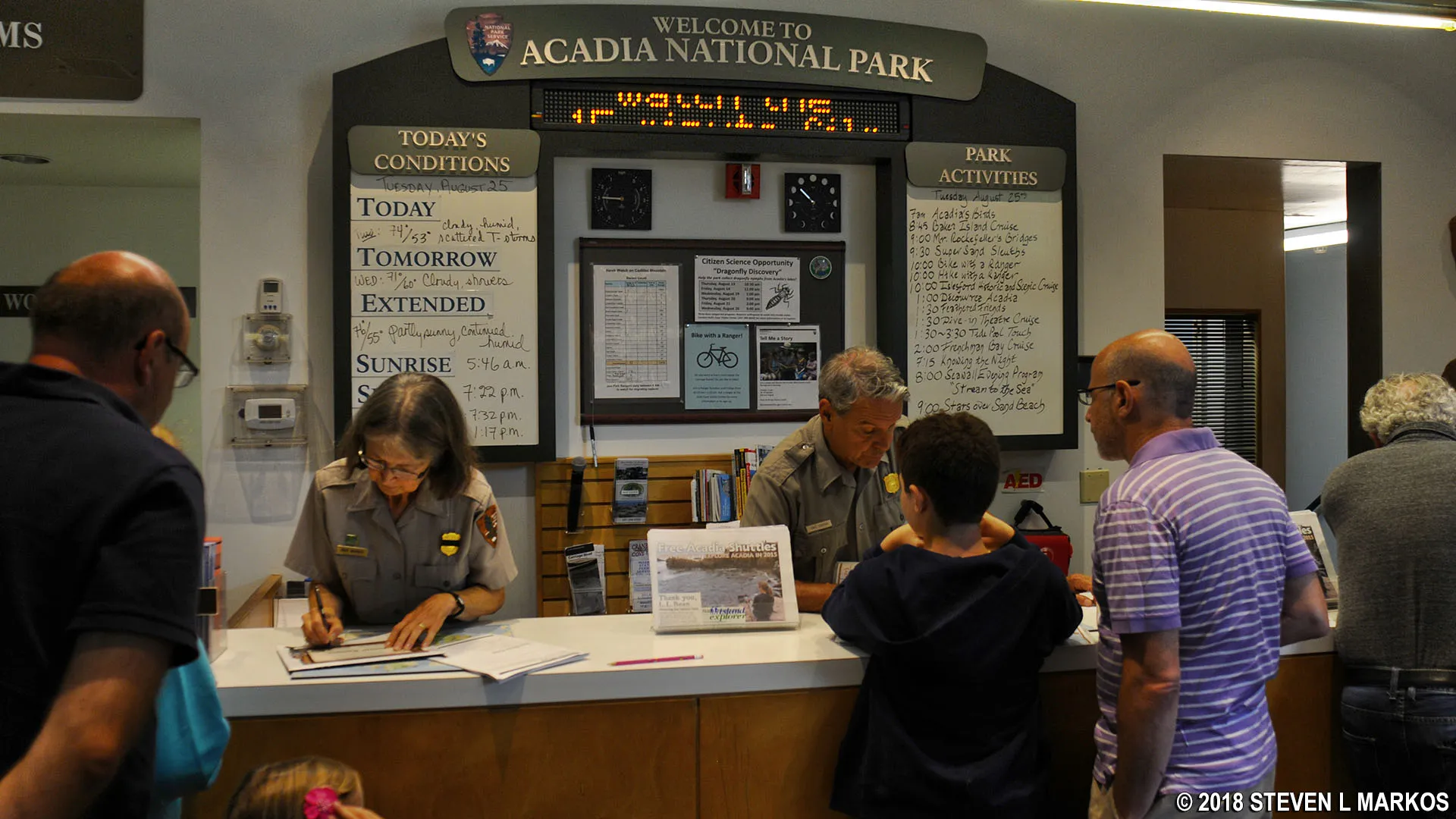
Check Out the Carriage Roads & Bridges
The carriage roads and bridges in Acadia National Park, funded by John D. Rockefeller between 1913 and 1940, span 45 miles. Duck Brook Bridge, constructed in 1929, is one of the nearest bridges to the Hulls Cove Visitor Center. Situated on the Witch Hole Pond loop, it is the tallest bridge in the park with three arches and four viewing platforms. The walk from the Visitor Center to the bridge is approximately 2 miles.

Get Stamped!
Passionate national park enthusiasts enjoy bringing along their National Parks Passport Books to collect stamps. Similar to a passport for international travel, you can gather stamps at every park or visitor center you explore.
Simply request a stamp from a park ranger or any staff member at the visitor center. The stamp will display the name of the Hulls Cove Visitor Center along with the date of your visit. If you don’t have an official National Parks Passport Book, you can still collect stamps on any paper or in your own notebook or journal.
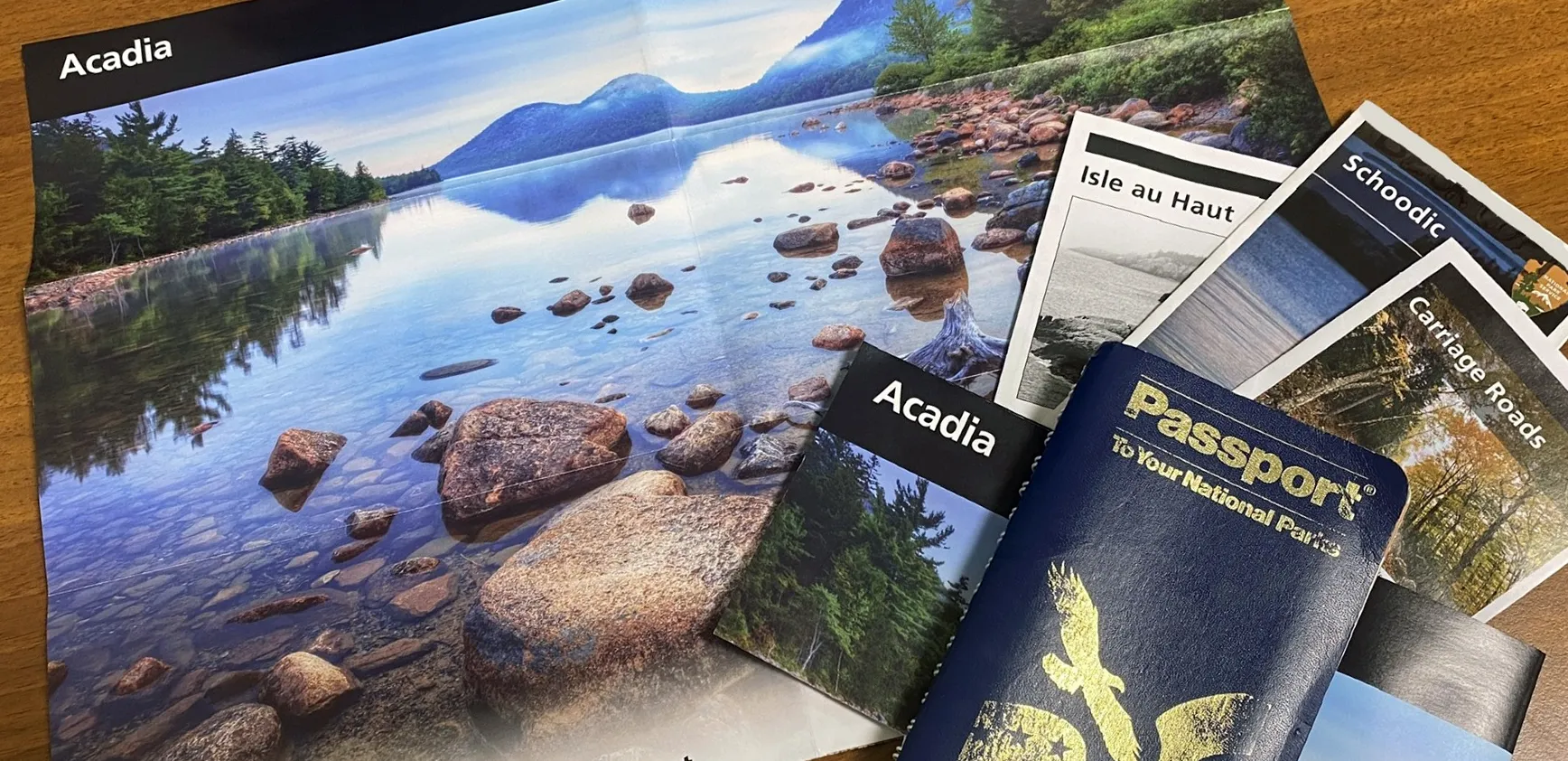
Programs and activities hosted by Acadia National Park Visitor Center
Acadia National Park offers various engaging programs through its Visitor Center, designed to enhance visitors’ experiences and knowledge about the park’s natural and cultural heritage. Here’s a detailed look at three notable programs: Ranger-led Programs, Junior Ranger Programs, and Seasonal Activities.
Ranger-led Programs
I’m really excited to share with you the Ranger-led programs at Acadia National Park Visitor Center, as they offer an amazing opportunity for visitors to learn about the park’s unique ecosystems, history, and wildlife. These programs typically run from May to October, with some options available year-round. Most programs last between 1 to 3 hours and are free of charge, although some specialized boat tours may require a fee.
Activities include guided walks along scenic trails, birdwatching, and evening campfire talks. For instance, the Peregrine Falcon Watch program, offered from late May through July, allows participants to observe nesting falcons with the aid of ranger-provided scopes. The programs are designed to be family-friendly and cater to various interests, making them both educational and enjoyable for all ages.
Junior Ranger Programs
As a parent or guardian, I know that you are always on the lookout for ways to encourage kids to develop a love for nature and exploration. That’s why I’m excited to share with you the Junior Ranger Program at Acadia National Park Visitor Center, a fantastic initiative that makes learning fun and engaging for young visitors.
This program is available year-round, so you can take advantage of it whenever you visit the park. The idea is simple: kids can pick up an activity booklet at any of the park’s visitor centers, which includes a series of fun and educational tasks related to the park’s unique features and ecosystems. As they complete the activities and attend ranger-led programs, they’ll earn a Junior Ranger badge or patch by taking an oath with a park ranger.
The best part? It’s completely free, although I suggest a nominal donation of $1.00 to cover the cost of the activity booklet and badge. This program not only helps foster a sense of responsibility and stewardship among young visitors but also provides them with a deeper understanding and appreciation of the park’s natural environment. It’s a win-win for kids and the park, and I highly recommend it for families and educators looking to make learning fun and interactive.
Seasonal Activities
From the warmth of summer to the serenity of winter, the Acadia National Park Visitor Center’s activities are carefully designed to cater to different interests and weather conditions.
In the summer, I highly recommend exploring the park’s carriage roads on a guided biking Acadia tour. These 2-3 hour tours not only provide a fun and leisurely way to experience the park’s scenic beauty but also offer insight into the historical significance of these paths. Imagine pedaling along the same roads that were built by the park’s early settlers, taking in the stunning views and learning about the region’s rich history.
As the seasons change and Acadia in winter arrives, the park is transformed into a winter wonderland, offering a range of activities such as cross-country skiing and snowshoeing on its extensive carriage road system. If you’re lucky, you might even catch a glimpse of the park’s wildlife, like deer and moose, playing in the snow.
But even in the darker months, the park still has plenty to offer. Special events like stargazing talks take advantage of Acadia’s incredibly dark skies, allowing visitors to learn about the constellations and celestial phenomena. Imagine gazing up at the stars, surrounded by the park’s peaceful atmosphere, and learning about the wonders of the universe. These seasonal activities are carefully designed to enhance visitors’ appreciation of Acadia’s diverse landscapes and ecosystems by Acadia National Park Visitor Center, making each visit unique and memorable.
Dining near the Hulls Cove Visitor Center
After exploring the Acadia National Park Visitor Center and the surrounding areas of Acadia National Park, you’re sure to work up an appetite. Fortunately, there are several dining options in the vicinity to satisfy your cravings.
Read More: Restaurants In Acadia National Park
Bar Harbor Lobster Bakes
Maine is famous for its lobster, so visitors will have plenty of the best places to visit in Acadia National Park along the coast. Bar Harbor Lobster Bakes is a popular local restaurant that has been serving lobster for over three decades.
The menu features dishes made with fresh, locally sourced ingredients, and diners can enjoy beautiful ocean views of Hulls Cove beach and Frenchman’s Bay.
Some of the top lobster dishes on the menu include lobster mac and cheese, Downeast lobster bake, creamy lobster stew, fresh lobster dinner, lobster rolls, and lobster melt panini. Non-lobster options include mussels, nachos, grilled steak, pulled pork, grilled cheese, burgers,…
To end your meal at Bar Harbor Lobster Bakes, try one of their famous Maine blueberry desserts like blueberry cake, blueberry pie, or blueberry a la mode.
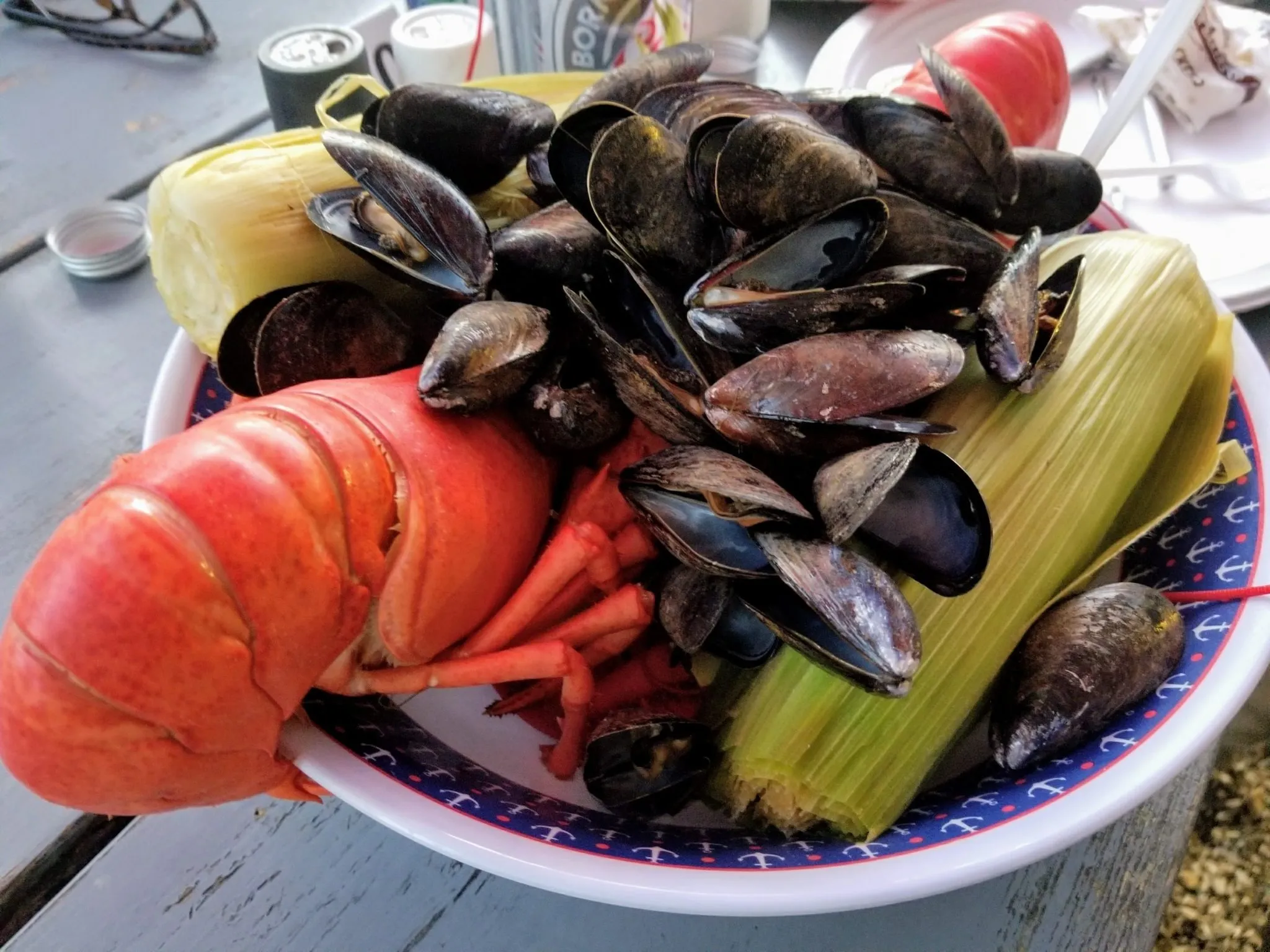
Jack Russell’s Prime Steak House
After exploring Acadia National Park and working up an appetite, visit Jack Russell’s Prime Steak House for a satisfying meal. This family-owned steakhouse is conveniently located in the hotel district of Bar Harbor and offers free parking.
Their menu includes a variety of seafood options such as lobster, crab cakes, haddock, and scallops, along with USDA prime beef dishes like filet mignon, New York strip, and ribeye. If you prefer non-meat or seafood options, they also offer pasta dishes and salads. Additionally, the restaurant has a full bar serving featured cocktails like blueberry margaritas and locally-grown mint mojitos.

Everyday Joe’s
Everyday Joe’s is a great choice for a relaxed breakfast or lunch in Bar Harbor. It is open year-round, making it a favorite among both locals and tourists visiting Acadia National Park. The restaurant offers a simple menu with options like omelets, pancakes, egg sandwiches, breakfast burritos, and quesadillas for breakfast, and salads, BLTs, wraps, sandwiches, and burgers for lunch. Additionally, Everyday Joe’s has a small convenience store and gas station for anyone in need of refueling.
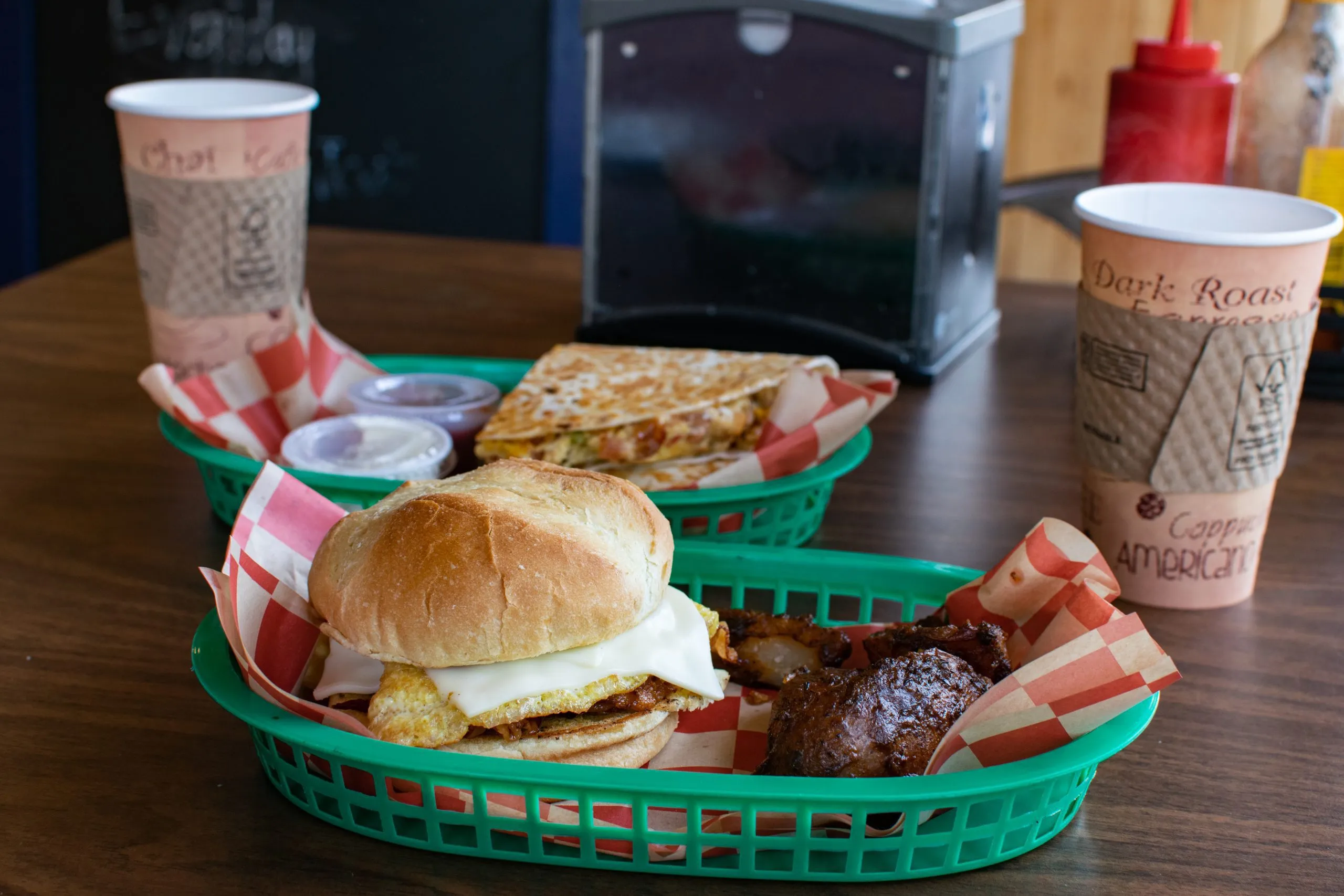
The Acadia National Park Visitor Center Hulls Cove is more than just a starting point for your adventure – it’s a treasure trove of information and activities that can enhance your visit. Make the most of your trip by starting from nationalparkshops.com‘s guide, you’ll be well-equipped to explore all the natural beauty and exciting experiences Acadia National Park has to offer.
Read More:
FAQs about the Acadia National Park Visitor Center
What are the hours of operation?
The Hulls Cove Visitor Center is open daily from 8:00 AM to 4:30 PM, typically from mid-May to mid-October. Hours may vary depending on the season, so it’s best to check the park website or call ahead for the most up-to-date information.
Is there an entrance fee to the visitor center?
No, there is no entrance fee to the Hulls Cove Visitor Center. However, if you plan to explore Acadia National Park, you will need to purchase an entrance pass, which can be obtained at the visitor center or online.
Are pets allowed at the visitor center?
Pets are generally allowed in the outdoor areas of the Hulls Cove Visitor Center, but they must be kept on a leash. Pets are not permitted inside the building, with the exception of service animals.
Is the visitor center fully accessible?
Yes, the Hulls Cove Visitor Center is designed with accessibility features, including wheelchair-accessible restrooms and ramps for easy access.
What services and amenities are available?
The visitor center offers a range of services and amenities, including an information desk, exhibits, a gift shop, restrooms, and a picnic area. Park rangers are also on-site to provide information and assistance.
